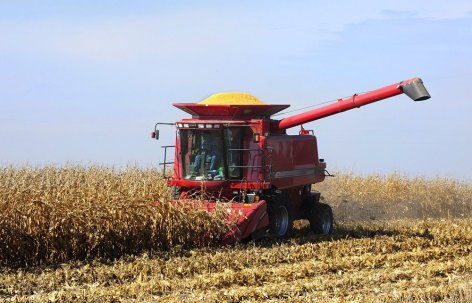
As the harvest reaches its peak in Iowa, recent government projections indicate that this year's yields will be better than what some feared during the height of this year's drought. Larger image. Photo by Robert Elbert.
AMES, Iowa – The latest government crop yield predictions may give grain farmers cause for optimism as the harvest season reaches its crescendo in Iowa, corn and soybean experts at Iowa State University said this week.
Although slightly lower than previous projections, last week’s crop yield report from the U.S. Department of Agriculture is a far cry from the worst-case scenarios many farmers braced for earlier this summer as a withering drought took hold of much of America’s prime farmland. USDA expects corn yields to come in at 122.8 bushels per acre, or about 0.6 bushels less than its August prediction.
Despite the downward adjustment, the projections paint a much rosier picture than the 110 bushels per acre many farmers feared they would get at the height of the drought, said Roger Elmore, an ISU Extension and Outreach corn specialist and a professor of agronomy.
“Some farmers are pretty happy going through the fields because things are a little better than the catastrophic scenarios that people were expecting,” Elmore said. “Yields are going to be less than they have been in recent years, but they aren’t quite as bad as we might have expected considering the historic nature of this year’s drought.”
Chad Hart, an ISU Extension and Outreach grain markets specialist and associate professor of economics, agreed with Elmore’s assessment.
“This year, we faced a major drought, but compared to some of the gloom-and-doom predictions, this crop fared a little better than some farmers were expecting,” Hart said. “It bodes well that we can have a severe drought and production can still carry through.”
Hart said the drought will snap the current streak of record-setting harvests in the United States, but, if the USDA projections pan out, it will still be the eighth-largest harvest in the country’s history.
Elmore said that the high demand, and resulting high commodity prices, also will take some of the financial sting out of this year’s harvest for grain farmers. The USDA’s most recent estimate of average corn prices, expressed as a range, was $7.20 to $8.60, with a midpoint of $7.90. That represents a small reduction in prices from last month, but the price remains elevated enough to alleviate some of the pain farmers could feel from the reduced yields.
Elmore said the harvest began hitting its stride in Iowa last week and will reach its peak this week, as long as the weather cooperates. The strain on the crops brought on by the dry conditions has sped up the harvest by about two weeks, both in Iowa and across the country, he said.
“When you put corn under stress it matures faster and usually looks uglier,” he said. “The plants shut down faster, and you start losing leaves. The ears of corn start tipping down earlier, and you end up with smaller and/or fewer kernels.”
The stress from the drought will also lead to greater yield variability from one field to the next, Elmore said. In some cases, yields can even vary widely between two different rows in the same field, he said. The stress endured by the plants throughout the summer amplifies the effect other important factors, such as seed depth and soil quality, have on the growth of the crops, resulting in a wide range of yields, he said.